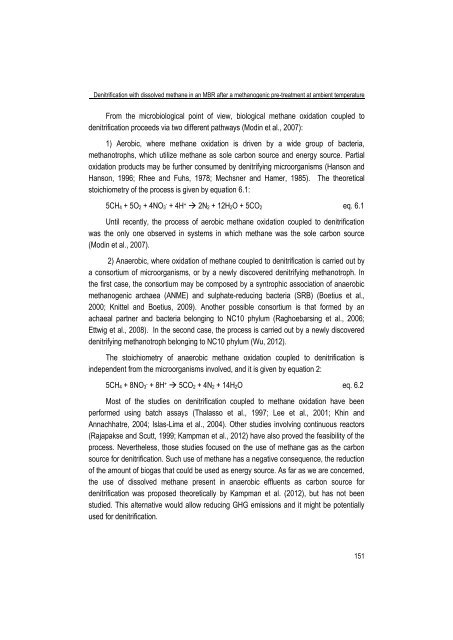Combining submerged membrane technology with anaerobic and ...
Combining submerged membrane technology with anaerobic and ...
Combining submerged membrane technology with anaerobic and ...
Create successful ePaper yourself
Turn your PDF publications into a flip-book with our unique Google optimized e-Paper software.
Denitrification <strong>with</strong> dissolved methane in an MBR after a methanogenic pre-treatment at ambient temperatureFrom the microbiological point of view, biological methane oxidation coupled todenitrification proceeds via two different pathways (Modin et al., 2007):1) Aerobic, where methane oxidation is driven by a wide group of bacteria,methanotrophs, which utilize methane as sole carbon source <strong>and</strong> energy source. Partialoxidation products may be further consumed by denitrifying microorganisms (Hanson <strong>and</strong>Hanson, 1996; Rhee <strong>and</strong> Fuhs, 1978; Mechsner <strong>and</strong> Hamer, 1985). The theoreticalstoichiometry of the process is given by equation 6.1:5CH 4 + 5O 2 + 4NO 3-+ 4H + 2N 2 + 12H 2O + 5CO 2 eq. 6.1Until recently, the process of aerobic methane oxidation coupled to denitrificationwas the only one observed in systems in which methane was the sole carbon source(Modin et al., 2007).2) Anaerobic, where oxidation of methane coupled to denitrification is carried out bya consortium of microorganisms, or by a newly discovered denitrifying methanotroph. Inthe first case, the consortium may be composed by a syntrophic association of <strong>anaerobic</strong>methanogenic archaea (ANME) <strong>and</strong> sulphate-reducing bacteria (SRB) (Boetius et al.,2000; Knittel <strong>and</strong> Boetius, 2009). Another possible consortium is that formed by anachaeal partner <strong>and</strong> bacteria belonging to NC10 phylum (Raghoebarsing et al., 2006;Ettwig et al., 2008). In the second case, the process is carried out by a newly discovereddenitrifying methanotroph belonging to NC10 phylum (Wu, 2012).The stoichiometry of <strong>anaerobic</strong> methane oxidation coupled to denitrification isindependent from the microorganisms involved, <strong>and</strong> it is given by equation 2:5CH 4 + 8NO 3-+ 8H + 5CO 2 + 4N 2 + 14H 2O eq. 6.2Most of the studies on denitrification coupled to methane oxidation have beenperformed using batch assays (Thalasso et al., 1997; Lee et al., 2001; Khin <strong>and</strong>Annachhatre, 2004; Islas-Lima et al., 2004). Other studies involving continuous reactors(Rajapakse <strong>and</strong> Scutt, 1999; Kampman et al., 2012) have also proved the feasibility of theprocess. Nevertheless, those studies focused on the use of methane gas as the carbonsource for denitrification. Such use of methane has a negative consequence, the reductionof the amount of biogas that could be used as energy source. As far as we are concerned,the use of dissolved methane present in <strong>anaerobic</strong> effluents as carbon source fordenitrification was proposed theoretically by Kampman et al. (2012), but has not beenstudied. This alternative would allow reducing GHG emissions <strong>and</strong> it might be potentiallyused for denitrification.151
















